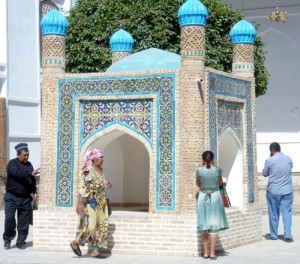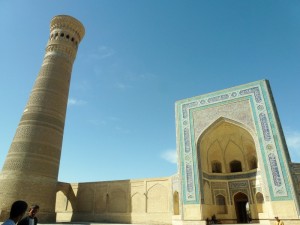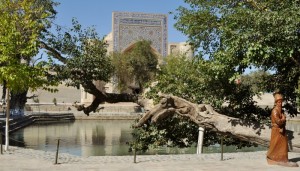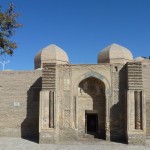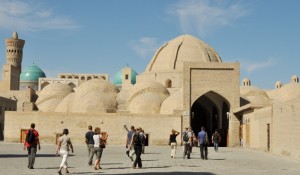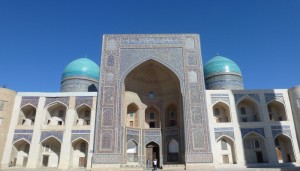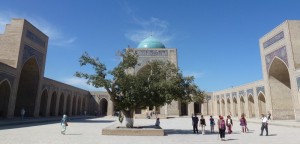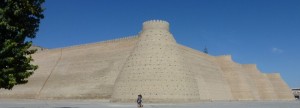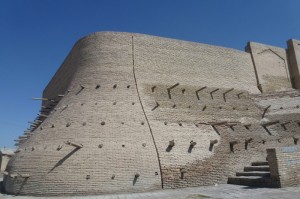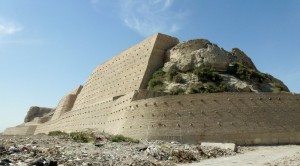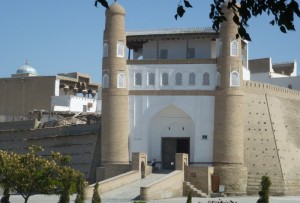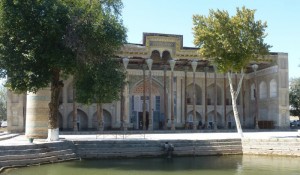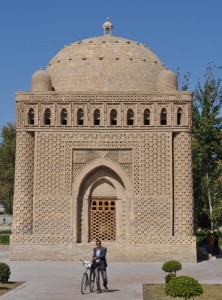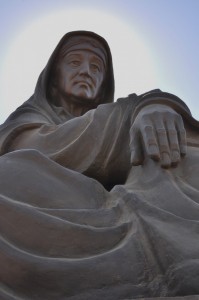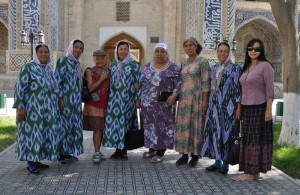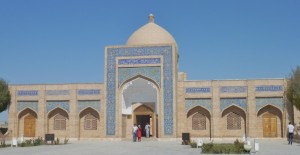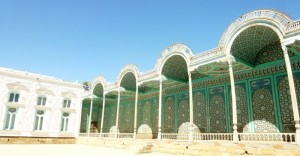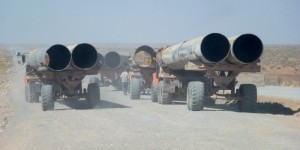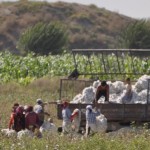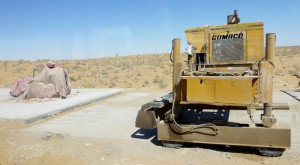Day 22 (August 16): Bukhara
Bukhara, one of the oldest cities in Central Asia, was the capital of the Samanid state in the 9th and 10th centuries and the Bukhara khanate of the Shaybanids in the 16th century. During this period, Bukhara flourished with dozens of specialist bazaars and caravanserais, more than 100 medressas (with 10,000 students) and more than 300 mosques. In 1753, Mohammed Rahim proclaimed himself emir founding the Mangit dynasty. Bukhara was absorbed in 1924 into the new Uzbek SSR.
Today, most of the old town is an architectural reserve filled with bazaars, caravanserais and medressas. It is regarded as the most complete and un-spoilt example of a medieval Central Asia town.
At 8:30am, Utkir took us on a guided walking tour. We started at Lyabi-Hauz by the statute of Hoja Nasruddin, a ‘wise fool’ who appears in Sufi teaching and tales around the world. There are three medressas surrounding the square namely the Nadir Divanbegi Medressa (east), Nadir Divanbegi Khanaka (west) and Kukeldash Medressa (north) (1569).
There are three famous covered bazaars. We first reached the Taqi Sarrafon (money-changers) and then the Taqi-Telpak Furushon (cap makers). In between these two bazaars, there is a small mosque, the Maghoki-Attar, which has been built upon a 5th– century Zoroastrian temple and Bukhara’s Jews are said to have used it as a synagogue. It has a 9th century façade and now houses a carpet museum.
Next, we arrived at two unrestored medressas. One was built by Ulugbek (1417) while the other by Abdul Aziz Khan in the 16th-century. A short distance away is the Taqi-Zargaron (jewelers).
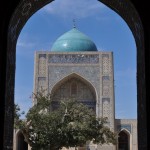 |
Then we reached the Kalon Minaret, built by the Karakhanid ruler Arslan Khan in 1127 which is 47m tall with a 10m-deep foundations. The top part was damaged by Frunze’s artillery in 1920 and has since been restored. Next to the minaret is the 16th-century Kalon Mosque which can accommodate 10,000 people. Opposite is the Mir-i-Arab Medressa which was built by a 16th-century sheikh from Yemen.
We passed through a new bazaar where dozens of locals were buying jewelry. We visited the Zindon (a prison with four dungeons including a big pit of 6.5m deep) before walking around the walls of the Ark which is a royal town-within-a-town.
The Ark is said to be the city’s oldest structure. As a part behind the entrance has collapsed two months ago, the Ark has been closed to visitors. What a pity!
We went onto the Bolo-Hauz Mosque, the Amirs’ official place of worship. It was built in 1718 and resembles those I have seen in Iran.
It’s time for lunch and I had two skewers of tasty shashlik and bread for 7000som. Very reasonable!
Our final stop was Ismail Samani Mausoleum (905) in Samani Park. It is the town’s oldest monument. I like this small and sturdy structure constructed with intricate baked-terracotta brickwork.
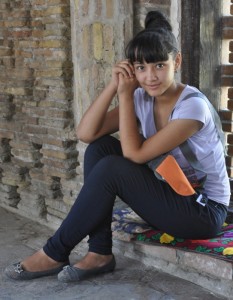 |
Led by James, we went on to see the Crying Mother Monument in honour of those who died in WWII. Then Jackie and I walked to the Abdella Khan and Modari Khan Medressas, and then the 16th-century Hammom Kunjak which charges US$25 for a bath and massage. It looks shabby and uncomfortable as compared with those in Turkey. Finally I got back to the hotel at 4:30pm after eight hours of walking!
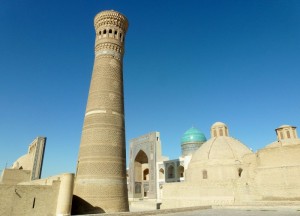 |
After resting for an hour and a half, I decided to go to the market to get food for dinner. But I got there too late and bought two pastries for 1000som. The sunset looked golden and enchanting.
Day 23 (August 17): Bukhara (30km)
We had a free day. I wandered leisurely and visited the Jewish Synagogue. Then Hortensia and I decided to take a taxi to see the Emir’s Palace. We ran into Utkir who arranged a taxi for 6000som. Then Robert appeared as he was also planning to make an excursion.
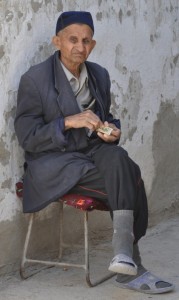 |
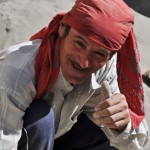 |
So three of us shared a taxi and visited three sites:
Bakhautdin Naqshband Mausoleum- It is one of Sufism’s important shrines. Bakhautdin Naqshband was the 14th century founder of one of the most influential ancient Sufi orders in Central Asia. He is also Bukhara’s unofficial ‘patron saint’.
Emir’s Summer Palace – The summer palace of the last emir, Alim Khan is now a museum displaying carpets, embroidery, porcelain, clothes etc. I find the architecture of the three- building compound designed by Russian architects (outside) and local artisans (inside) weird. As there was a small explosion, the power was cut and we could not really see some of the exhibits. Anyway, the entrance fee of 6000som is not value for money!
Chor-Bakr- This 16th century necropolis (town of mausoleum) resembles Shahr- I – Zindah in Samarkand. It was built in Shaybanid times near the graves of Abu-Bakr, devoted friend of the Prophet Mohammed and later the first caliph and his family. There are also two huge but haunting mosques in the complex.
We finished our tour at 2pm, brought a delicious grilled chicken (2000som) and had picnic lunch at the hotel’s courtyard.
I ran into Robert in the old town and dragged him along to watch sunset at the roof of the Dolon Restaurant. The sunset was not great and the waiter charged us 7500som for a draft beer. It was overpriced!
Day 24 (August 18): Bukhara – Khiva (460km)
The scenery also changed dramatically. About an hour’s drive out of Bukhara, the cultivated land gives way to semi-desert vegetation without habitation. There are some sand dunes which are not too picturesque. Then we stopped for lunch by the Oxus River around 2pm. When we approached Khiva, the cotton and maize fields came into sight again. We finally arrived at our hotel at Khiva at 6:30pm. What a day!


